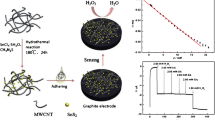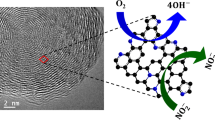Abstract
Single-atom catalysts received increasing attention due to their maximum atom utilization efficiency. However, metal-free single atoms have not been used to construct electrochemical sensing interfaces. In this work, we demonstrated the use of Se single atoms (SA) as electrocatalyst for sensitive electrochemical nonenzymatic detection of H2O2. Se SA was synthesized and anchored on nitrogen-doped carbon (Se SA/NC) via a high-temperature reduction strategy. The structural properties of Se SA/NC were characterized by transmission electron microscopy (TEM), high-angle annular dark-field scanning transmission electron microscopy (HAADF-STEM), energy-dispersive spectroscopy (EDS), X-ray photoelectron spectroscopy (XPS), X-ray diffraction (XRD), and electrochemical techniques. The results showed that Se atoms were uniformly distributed on the surface of the NC. The obtained SA catalyst exhibited excellent electrocatalytic activity toward H2O2 reduction, and can be used to detect H2O2 in a wide linear range from 0.04 mM to 11.1 mM with a low detection limit of 0.018 mM and high sensitivity of 403.9 µA mM−1 cm−2. Moreover, the sensor can be used for the quantification of H2O2 concentration in real disinfectant samples. This work is of great significance for expanding the application of nonmetallic single-atom catalysts in the field of electrochemical sensing.
Graphical abstract
Se single atoms (Se SA) as novel electrocatalyst were synthesized and anchored on nitrogen-doped carbon (NC) for sensitive electrochemical nonenzymatic detection of H2O2









Similar content being viewed by others
References
Jia NM, Huang BZ, Chen LN, Tan L, Yao SZ. A simple non-enzymatic hydrogen peroxide sensor using gold nanoparticles-graphene-chitosan modified electrode. Sens Actuat B. 2014;195:165.
Gao Y, Zhang ZY, Zhang XF, Deng ZP, Huo LH, Gao S. CuMn2O4 spinel nanoflakes for amperometric detection of hydrogen peroxide. ACS Appl Nano Mater. 2021;4:6832.
Liu HY, Weng LY, Yang C. A review on nanomaterial-based electrochemical sensors for H2O2, H2S and NO inside cells or released by cells. Microchim Acta. 2017;184:1267.
Dhara K, Mahapatra DR. Recent advances in electrochemical nonenzymatic hydrogen peroxide sensors based on nanomaterials: a review. J Mater Sci. 2019;54:12319.
Chen AC, Chatterjee S. Nanomaterials based electrochemical sensors for biomedical applications. Chem Soc Rev. 2013;42:5425.
Hu Y, Hojamberdiev M, Geng DS. Recent advances in enzyme-free electrochemical hydrogen peroxide sensors based on carbon hybrid nanocomposites. J Mater Chem C. 2021;9:6970.
Qian LT, Durairaj S, Prins S, Chen AC. Nanomaterial-based electrochemical sensors and biosensors for the detection of pharmaceutical compounds. Biosens Bioelectron. 2021;175: 112836.
Simsek M, Wongkaew N. Carbon nanomaterial hydrids via laser writing for high-performance non-enzymatic electrochemical sensors: a critical review. Anal Bioanal Chem. 2021;413:6079.
Shamkhalichenar H, Choi JW. Review-non-enzymatic hydrogen peroxide electrochemical sensors based on reduced graphene oxide. J Electrochem Soc. 2020;167: 037531.
Duan ZH, Huang CL, Yang XX, Hu AL, Lu XY, Jiang Q. Preparation of SnS2/MWCNTs chemically modified electrode and its electrochemical detection of H2O2. Anal Bioanal Chem. 2020;412:4403.
Li ZZ, Xin YM, Wu WL, Fu BH, Zhang ZH. Topotactic conversion of copper(I) phosphide nanowires for sensitive electrochemical detection of H2O2 release from living cells. Anal Chem. 2016;88:7724.
Ahmad K, Mobin SM. Design and fabrication of cost-effective and sensitive non-enzymatic hydrogen peroxide sensor using Co-doped δ-MnO2 flowers as electrode modifier. Anal Bioanal Chem. 2021;413:789.
Wang TY, Zhu HC, Zhuo JQ, Zhu ZW, Papakonstantinou P, Lubarsky G, Lin J, Li MX. Biosensor based on ultrasmall MoS2 nanoparticles for electrochemical detection of H2O2 released by cells at the nanomolar level. Anal Chem. 2013;85:10289.
Shao MH, Peles A, Shoemaker K. Electrocatalysis on platinum nanoparticles: particle size effect on xxygen reduction reaction activity. Nano Lett. 2011;11:3714.
Cheng NC, Zhang L, Doyle-Davis K, Sun XL. Single-atom catalysts: from design to application. Electrochem Energy Rev. 2019;2:539.
Zhang L, Doyle-Davis K, Sun XL. Pt-based electrocatalysts with high atom utilization efficiency: from nanostructures to single atoms. Energy Environ Sci. 2019;12:492.
Song ZX, Zhu YN, Liu HS, Banis MN, Zhang L, Li JJ, Doyle-Davis K, Li RY, Sham TK, Yang LJ, Young A, Botton GA, Liu LM, Sun XL. Engineering the low coordinated Pt single atom to achieve the superior electrocatalytic performance toward oxygen reduction. Small. 2020;16:2003096.
Zhang QQ, Guan JQ. Single-atom catalysts for electrocatalytic applications. Adv Funct Mater. 2020;30:2000768.
Guo WX, Wang ZY, Wang XQ, Wu YE. General design concept for single-atom catalysts toward heterogeneous catalysis. Adv Mater. 2021;33:2004287.
Hou HF, Mao JJ, Han YH, Wu F, Zhang MN, Wang DS, Mao LQ, Li YD. Single-atom electrocatalysis: a new approach to in vivo electrochemical biosensing. Sci China Chem. 2019;62:1720.
Ding SC, Lyu ZY, Fang LZ, Li T, Zhu WL, Li SQ, Li X, Li JC, Du D, Lin YH. Single-atomic site catalyst with heme enzymes-like active sites for electrochemical sensing of hydrogen peroxide. Small. 2021;17:2100664.
Hu H, Wang JJ, Cui BF, Zheng XR, Lin JG, Deng YD, Han XP. Atomically dispersed selenium sites on nitrogen-doped carbon for efficient electrocatalytic oxygen reduction. Angew Chem Int Ed. 2022;61: e202114441.
Shen SQ, Sun YY, Sun H, Pang YP, Xia SX, Chen TQ, Zheng SY, Yuan T. Research progress in ZIF-8 derived single atomic catalysts for oxygen reduction reaction. Catalysts. 2022;12:525.
Yang ZK, Chen BX, Chen WX, Qu YT, Zhou FY, Zhao CM, Xu Q, Zhang QH, Duan XZ, Wu YE. Directly transforming copper (I) oxide bulk into isolated single-atom copper sites catalyst through gas-transport approach. Nat Commun. 2019;10:3734.
Lien TL, Le Nguyen, KKA, Phan NTS. A zeolite imidazolate framework ZIF-8 catalyst for friedel-crafts acylation. Chin J Catal. 2012;33:688.
Biswas S, Chen Y, Xie Y. Ultrasmall Au (0) inserted hollow PCN-222 MOF for the high-sensitive detection of estradiol. Anal Chem. 2020;92:4566.
Niu X, Lan M, Zhao H. Highly sensitive and selective nonenzymatic detection of glucose using three-dimensional porous nickel nanostructures. Anal Chem. 2013;85:3561.
Chen XR, Gao J, Zhao GQ, Wu C. In situ growth of FeOOH nanoparticles on physically-exfoliated graphene nanosheets as high performance H2O2 electrochemical sensor. Sens Actuat B. 2020;313: 128038.
Ye MF, Yang C, Sun Y, Wang JY, Wang DD, Zhao YJ, Zhu Z, Liu PC, Zhu JH, Li CS, Peng WX, Zhang N, Dong YP. ZnFe2O4/Graphitic carbon nitride nano/microcomposites for the enhanced electrochemical sensing of H2O2. ACS Appl Nano Mater. 2022;5:10922.
Xie FY, Cao XQ, Qu FL, Asiri AM, Sun XP. Cobalt nitride nanowire array as an efficient electrochemical sensor for glucose and H2O2 detection. Sens Actuat B. 2018;255:1254.
Wang HF, Chen WX, Chen QY, Liu N, Cheng HJ, Li T. Metal-organic framework (MOF)-Au@Pt nanoflowers composite material for electrochemical sensing of H2O2 in living cells. J Electroanal Chem. 2021;897: 115603.
Rajaitha PM, Hajra S, Padhan AM, Panda S, Sahu M, Kim HJ. An electrochemical sensor based on multiferroic NdFeO3 particles modified electrode for the detection of H2O2. J Alloy Compd. 2022;915: 165402.
Liu Y, Zhao P, Liang Y. Single-atom nanozymes Co-N-C as an electrochemical sensor for detection of bioactive molecules. Talanta. 2023;254: 124171.
Hui Y, Yang D, Wang W. A label-free electrochemical aptasensor based on a gold nanoparticle/carbon nanotube/meta-organic framework nanohybrid for ultrasensitive detection of streptomycin in milk samples. Food Chem. 2023;402: 134150.
Acknowledgements
This work is financially supported by National Natural Science Foundation of China (No. 21575002). Natural Science Foundation of Anhui Province (No. 2108085MB66).
Author information
Authors and Affiliations
Corresponding authors
Ethics declarations
Conflict of interest
Wei Wang is Editor of Analytical and Bioanalytical Chemistry but was not involved in the peer review of this paper. The other authors declare that they have no conflict of interest.
Additional information
Publisher's note
Springer Nature remains neutral with regard to jurisdictional claims in published maps and institutional affiliations.
Rights and permissions
Springer Nature or its licensor (e.g. a society or other partner) holds exclusive rights to this article under a publishing agreement with the author(s) or other rightsholder(s); author self-archiving of the accepted manuscript version of this article is solely governed by the terms of such publishing agreement and applicable law.
About this article
Cite this article
Qi, C., Wang, W. & Dong, Y. Synthesis of Se single atoms on nitrogen-doped carbon as novel electrocatalyst for sensitive nonenzymatic sensing of hydrogen peroxide. Anal Bioanal Chem 415, 5391–5401 (2023). https://doi.org/10.1007/s00216-023-04814-4
Received:
Revised:
Accepted:
Published:
Issue Date:
DOI: https://doi.org/10.1007/s00216-023-04814-4




